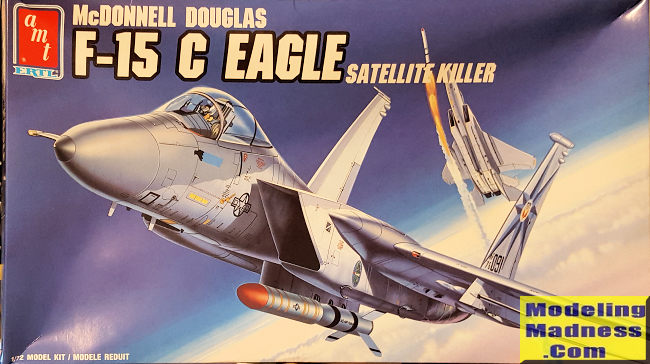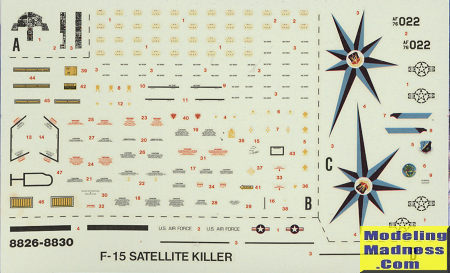
| KIT #: | 8826 |
| PRICE: | $10.00 when new |
| DECALS: | One option |
| REVIEWER: | Scott Van Aken |
| NOTES: | Reboxed ESCI kit |

| HISTORY |
The ASM-135 ASAT is an air-launched anti-satellite multistage missile that was developed by Ling-Temco-Vought's LTV Aerospace division. The ASM-135 was carried exclusively by United States Air Force (USAF) F-15 Eagle fighter aircraft. In order to provide the proper trajectory to the target, the F-15 host aircraft is literally flown by the missile in a zoom maneuver to reach the proper release altitude.
The United States Air Force intended to modify 20 F-15A fighters from the 318th Fighter Interceptor Squadron based at McChord Air Force Base in Washington and the 48th Fighter-Interceptor Squadron based at Langley Air Force Base in Virginia for the anti-satellite mission. Both squadrons had airframes modified to support the ASM-135 by the time the project was cancelled in 1988. An interesting note is that modified aircraft had the gun removed to provide space for helium coolant for the missile.
The USAF had planned to deploy an operational force of 112 ASM-135 missiles.
The deployment of the ASM-135 was central to a policy debate in the United States over the strategic need for an anti-satellite weapon and the potential for anti-satellite weapon arms control with the Soviet Union. Starting in 1983, Congress placed various restrictions on the ASM-135 program, and in December 1985, banned testing the ASM-135 on targets in space. This decision was made only a day after the Air Force sent two target satellites into orbit for its next round of tests. The Air Force continued to test the ASAT system in 1986, but stayed within the limits of the ban by not engaging a space-borne target.
In the same year the deployment of the ASM-135 was estimated to cost $US5.3 billion up from the original $US500 million estimate. The USAF scaled back the ASM-135 program by two-thirds in attempt to control costs. The USAF also never strongly supported the program and proposed canceling the program in 1987. In 1988, the Reagan Administration canceled the ASM-135 program because of technical problems, testing delays, and significant cost growth.
In recent years, the Russians have continued the development and some say the deployment of anti-satellite missiles.
| THE KIT |
First thing to mention is that the aircraft modified to carry the ASAT were not F-15C aircraft, but F-15As. Indeed, the serial number on the decal sheet is for an F-15A. Fortunately, the only real external difference between the A and C models is that initially the F-15C did not have the 'turkey feathers' on the burner cans. The kit provides both styles.
You get a pretty standard cockpit tub with three piece seat, stick and instrument panel. Decals are supplied for the instruments. Wings are separate upper and lower halves with the holes for the pylons pre-drilled into the lower wings. Fuselage is a single lower section with two upper sections, the cockpit area being one of those so that the two seat version can be done with the same basic tooling. The nose cone is separate and you will need 5 grams of weight.
Intakes are a left and right half with an upper section for the ramp to be installed. A blanking plate that has half a first stage compressor molded in place fits behind the intake assembly when you are gluing the intakes in place. As mentioned, there are two sets of exhaust. You have a choice of with and without 'turkey feathers' so check your references. At this stage, wings, tailplanes and fins are attached. The larger 'bullet' for the left fin is separate and needs to be attached at this time. Next step is for the landing gear. These are nicely done and should be fine as is
What is different from the other ESCI F-15s is that this
one includes the ASM-135 and pylon. Interestingly, AMT feels
 that these
planes would not carry wing pylons, which leaves you holes to fill. While the
box art does show the wing pylons in place, you get no fuel tanks and no weapons
or missile pylons, those portions of the sprues being left off for this one. So
your options are to rob the bits from some other 1/72 F-15 or fill the holes.
that these
planes would not carry wing pylons, which leaves you holes to fill. While the
box art does show the wing pylons in place, you get no fuel tanks and no weapons
or missile pylons, those portions of the sprues being left off for this one. So
your options are to rob the bits from some other 1/72 F-15 or fill the holes.
Instructions are nicely done with what appears to be Humbrol paint references. There is one markings option and that is 76-0022, an F-15A attached to the 318 FIS. Interestingly, every kit I've seen for an ASAT-carrying F-15 has used this one airplane as its decals. Not surprising is that the box art is not this particular aircraft. The sheet is nicely printed and provides a lot of stencils for you to attach. It also includes decals for the ASAT. These are a bit thick and glossy, but should not provide any issues.
| CONCLUSIONS |
This is a pretty nice 1/72 F-15. Not as detailed or as fiddly as those by Hasegawa or Academy, but then it is an older tooling. It does have engraved panel lines, which adds to its appeal and can generally be found in the $10-15.00 range from the second hand market.
August 2021
Copyright ModelingMadness.com. All rights reserved. No reproduction in part or in whole without express permission.
If you would like your product reviewed fairly and fairly quickly, please contact the editor or see other details in the Note to Contributors.